Entomology for Master Gardeners: Part 4
Insect Orders with Complete Metamorphosis
Listed below are the most important insect orders found in Kentucky gardens that have complete metamorphosis. The previous section, Insect Orders I: Complete Metamorphosis, covers the other insect orders that are part of the Kentucky Master Gardener curriculum.
Neuroptera (Lacewings, Antlions, Dobsonflies)
These insects have two pairs of long wings that are crisscrossed with many fine veins and held rooflike over their backs. Common species in home landscapes and gardens are predators; adults and larvae feed on many soft-bodied insects such as aphids. The green lacewing is the most common species in gardens, but all insects in this order are considered beneficial when they occur in gardens.

Green Lacewing eggs (Whitney Cranshaw, Colorado State University, Bugwood.org), larva (David Cappaert, Bugwood.org), and adult (Whitney Cranshaw, Colorado State University, Bugwood.org)
Coleoptera (Beetles)
This is the largest order of insects, containing about one-third of all known insect species. Shield-like front wings are the defining feature of most beetles. They are usually very tough and protect the hind pair of flying wings that are folded efficiently beneath them when the beetle is at rest. Look for a line down the middle of the back where the hard wings come together. Some beetles, such as lightning bugs or firelies, soldier beetles, and blister beetles, have soft, flexible front wings. Many larval forms can be found in this order, including white grubs, wireworms, and legless grubs. In terms of feeding habits, this species includes leaf feeders, leafminers, borers, predators, and scavengers.
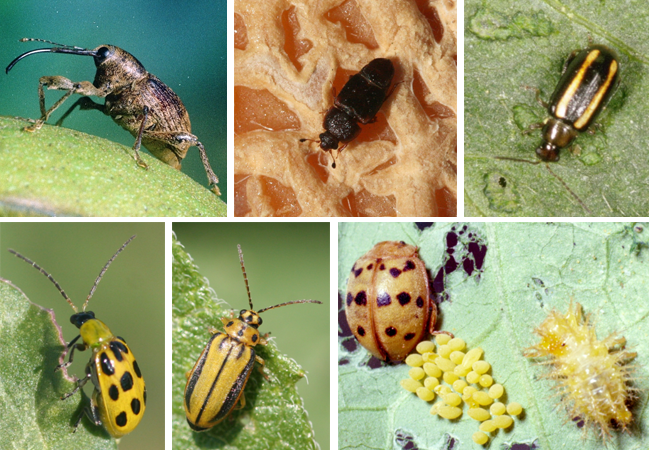
Some beetles that can be pests in garden and yards: Pecan Weevil (Clemson University - USDA Cooperative Extension Slide Series, Bugwood.org), Dusky Sap Beetle (Whitney Cranshaw, Colorado State University, Bugwood.org), Palestriped Flea Beetle (Frank Peairs, Colorado State University, Bugwood.org), Spotted Cucumber Beetle (Whitney Cranshaw, Colorado State University, Bugwood.org), Elm Leaf Beetle (Whitney Cranshaw, Colorado State University, Bugwood.org), Mexican Bean Beetle eggs, larva, and adult (Clemson University - USDA Cooperative Extension Slide Series, Bugwood.org)
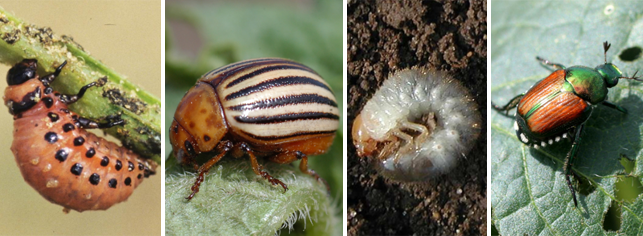
Some beetle pests and their larvae: Colorado Potato Beetle larva (Gerald Holmes, California Polytechnic State University at San Luis Obispo, Bugwood.org) and adult (Ward Upham, Kansas State University, Bugwood.org); Japenese Beetle grub (David Cappaert, Bugwood.org) and adult (Roger Schmidt, University of Wisconsin-Madison, Bugwood.org)

Some beneficial predatory beetles found in gardens: Pink Lady Beetle with eggs (Whitney Cranshaw, Colorado State University, Bugwood.org), Lady Beetle larva (Clemson University - USDA Cooperative Extension Slide Series, Bugwood.org), Ground Beetle (upper right, Jim Jasinski, Ohio State University Extension, Bugwood.org), Ground Beetle larva (lower right, Joseph Berger, Bugwood.org)
Lepidoptera (Moths and Butterflies)
This is the second largest insect order. There are many important pest species in this group. Many of the larvae are leaf feeders, borers, and leaf miners. Adults do not damage plants directly. Butterflies and moths have coiled, siphoning mouth-parts and two pairs of wings covered with scales. Brightly colored butterflies, which fly mostly in the day, have long, thin antennae with a knob on the end. Drab-colored moths, which typically fly at night, have feathery or spindle-shaped antennae. There are few pest butterfly species in Kentucky gardens, but many moth pests.
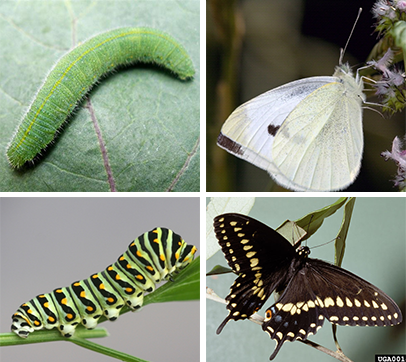
A few butterfly species can be garden pests. Top: Cabbageworm caterpillar (Ansel Oommen, Bugwood.org) and adult (David Cappaert, Bugwood.org); Bottom: Black Swallowtail caterpillar (Whitney Cranshaw, Colorado State University, Bugwood.org) and adult (Gerald J. Lenhard, Louisiana State University, Bugwood.org)
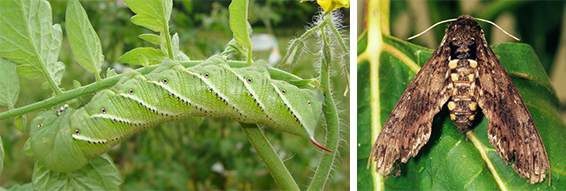
Tomato Hornworm caterpillar (Eric R. Day, Virginia Polytechnic Institute and State University, Bugwood.org) and adult (Jim Occi, BugPics, Bugwood.org)

Several cutworm and looper species are pests of garden plants: Variegated Cutworm caterpillar (James Kalisch, University of Nebraska, Bugwood.org) and adult (Tony Davison, Bugwood.org), Cabbage Looper caterpillar (Alton N. Sparks, Jr., University of Georgia, Bugwood.org) and cdult (Keith Naylor, Bugwood.org)
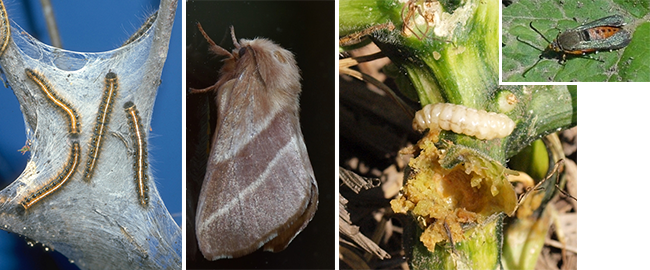
Eastern Tent Caterpillar with silk tents (Robert F. Bassett, USDA Forest Service, Bugwood.org), and adult (Vern Wilkins, Indiana University, Bugwood.org) Squash Vine Borer caterpillar (Jim Jasinski, Ohio State University Extension, Bugwood.org) and adult (inset, Jim Jasinski, Ohio State University Extension, Bugwood.org)
Diptera (Flies, Mosquitoes, Gnats)
Diptera literally means two wings, which is the defining trait of this order (the insects in most other orders have four total wings). The front wing is usually clear with some distinct veins, while the hind pair is modified into a small balancing structure that resembles a golf tee. Fly antennae may be short or long and of various shapes; the eyes usually are large. The mouthparts of insects in this diverse order are modified in various ways to feed on liquids. The adults of some species live only a few days and don’t feed. The larvae are legless; most live in a moist habitat or in water but a few are terrestrial. Examples of fly larvae include maggots and mosquito wrigglers. Some species are important beneficial parasites of caterpillars and beetle larvae. A few species are pests in gardens, including gall makers, leafminers, and maggots that feed on fruit, onions, and other plants. As with moths and butterflies, it it generally the larvae that actually damage plants, rather than adult flies.

Often, the effects of fly damage are observed, rather than the flies or larvae themselves. Columbine Leafminer damage (John A. Weidhass, Virginia Polytechnic Institute and State University, Bugwood.org) and Oak Leaf Gall (Bruce Watt, University of Maine, Bugwood.org)
 Seedcorn Maggot in onion seedling (Whitney Cranshaw, Colorado State University, Bugwood.org), Spotted Wing Drosophila on berries (upper right, Hannah Burrack, North Carolina State University, Bugwood.org), Apple Maggot larva (lower right, Whitney Cranshaw, Colorado State University, Bugwood.org)
Seedcorn Maggot in onion seedling (Whitney Cranshaw, Colorado State University, Bugwood.org), Spotted Wing Drosophila on berries (upper right, Hannah Burrack, North Carolina State University, Bugwood.org), Apple Maggot larva (lower right, Whitney Cranshaw, Colorado State University, Bugwood.org)
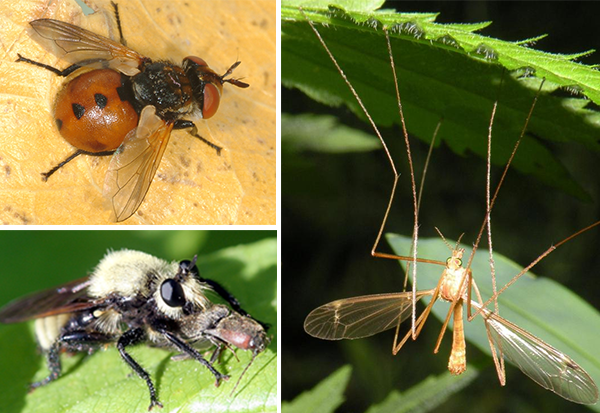
Many flies found in gardens are not plant pests. Parasitic llies like the one above left lay their eggs on other insects (Joseph Berger, Bugwood.org). Robber Flies (lower left) are predators that catch insect in the air (David Cappaert, Bugwood.org). Crane Flies (right) resemble mosquitoes but do not bite. Their larvae are important decomposers (Jessica Louque, Smithers Viscient, Bugwood.org).
Hymenoptera (Bees, Wasps, Sawflies, Ants)
Hymenoptera have some type of chewing mouthparts. Most have two pairs of wings, but some forms (such as worker ants) have no wings. When wings exist, the front pair is longer than the hind pair. The antennae are usually well developed and often long. Most Hymenoptera species lead solitary lives; others are organized into highly socialized colonies. Honey bees display the highest degree of social organization among insects in this order. Some Hymenoptera (including dozens of bee species in Kentucky) are beneficial pollinators, as they visit flowers while collecting pollen. About 50% of the species are beneficial predators and parasites of other insects. Sawfly larvae, which resemble caterpillars, feed on leaves. Several species of small wasps produce galls on plants.
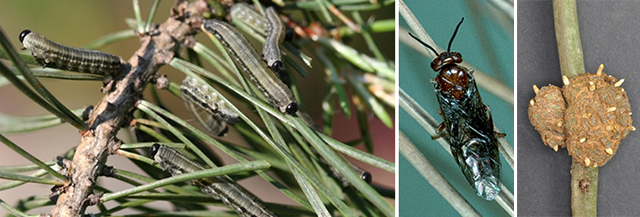
European Pine Sawly larvae (Steven Katovich, USDA Forest Service, Bugwood.org) and adult European Pine Sawfly (Louis-Michel Nageleisen, Département de la Santé des Forêts, Bugwood.org), Horned Oak Gall (Lorraine Graney, Bartlett Tree Experts, Bugwood.org)
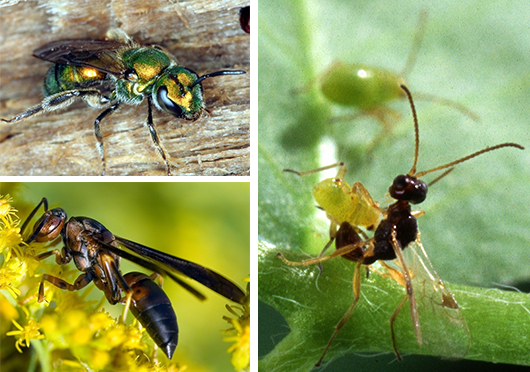
Beneficial Hymenoptera. Shown above left are a Solitary Bee, an important pollinator, a Paper Wasp (lower left), a predator that kills many garden pests (David Cappaert, Bugwood.org). On the right is a parasitic wasp laying its eggs inside a aphid (Scott Bauer, USDA Agricultural Research Service, Bugwood.org)
NEXT: Learn more about insect biology and insect damage to better understand how to diagnose problems in the garden.
